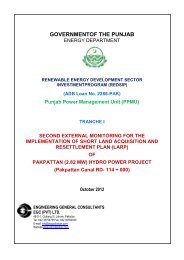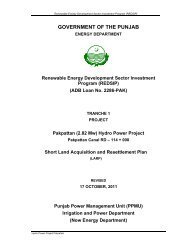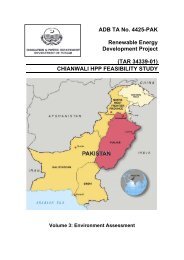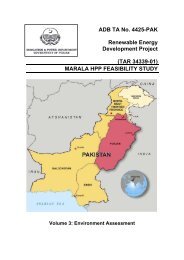Chief Minister's Ujaala Programme - Energy Department, Govt. of ...
Chief Minister's Ujaala Programme - Energy Department, Govt. of ...
Chief Minister's Ujaala Programme - Energy Department, Govt. of ...
- No tags were found...
You also want an ePaper? Increase the reach of your titles
YUMPU automatically turns print PDFs into web optimized ePapers that Google loves.
1 Name <strong>of</strong> the ProjectREVISED PC-IInfrastructure Sector“<strong>Chief</strong> Minister’s <strong>Ujaala</strong> <strong>Programme</strong>”2 LocationEntire Punjab3 Authorities responsible for:(i)Sponsorship<strong>Energy</strong> <strong>Department</strong>, Government <strong>of</strong> the Punjab(ii)(iii)(iv)Execution<strong>Energy</strong> <strong>Department</strong> and School Education <strong>Department</strong>,Government <strong>of</strong> the PunjabOperation and Maintenance• The beneficiary shall be responsible for overall operation andmaintenance <strong>of</strong> the system.• However for any malfunctioning, troubleshooting ormaintenance covered under the warranty <strong>of</strong> 2 years, the O&MServices would be provided by the Contractor during warrantyperiod <strong>of</strong> 2 years.• Schools Education <strong>Department</strong> will monitor the O&M duringthe warranty period <strong>of</strong> 2 years. <strong>Energy</strong> <strong>Department</strong> will providethe requisite technical back stopping to ensure smoothfunctioning <strong>of</strong> system provided.Concerned Federal MinistryMinistry <strong>of</strong> Water and Power4. Plan ProvisionGovernment <strong>of</strong> the Punjab has allocated Rs.1000 Million for the programme“Provision <strong>of</strong> Solar Panels to Households below the Poverty Line” in the provincialAnnual Development Program (ADP) 2012-13. Additional financial resources5
would be channelized during the currency <strong>of</strong> the year as and when required beinga priority programme.Total BlockProvisionAmount AlreadyCommittedAmount for theProjectBalance AvailableNot Available5. Project Objectives and its Relationship with Sectoral ObjectivesPresently Pakistan/Punjab is suffering immensely due to <strong>Energy</strong> shortage.The current Power deficits is increasing with every day goes by. The situation isaggravating with 10% additional energy demand every year. This has affectedadversely the national life <strong>of</strong> all segments <strong>of</strong> society alike. The Prolonged loadshedding i.e Power outages has crippled economic base <strong>of</strong> the province resultingin compounding forced un-employment, low purchasing power <strong>of</strong> the people andleading to increase in poverty. This phenomenon has thrown the people at themargin below the poverty line. This has also caused the substantial increase incrimes as well. Government <strong>of</strong> the Punjab is committed to develop viable &affordable solution to current energy crisis. The prime objective is that the solutionis economically viable, technically feasible, cost efficient and environment friendly.For the accomplishment <strong>of</strong> this objective, the Government has consideredintensively various alternatives with experts panel, academia & industry. TheGovernment has adopted consultative approach to devise best suited solution forthe attainment <strong>of</strong> the overall objective “to mitigate the sufferings <strong>of</strong> the peoplespecially the poorest strata <strong>of</strong> society arising out <strong>of</strong> <strong>Energy</strong> deficits within shortestpossible time span”. Therefore in line with this objective, “Solar Home Solution”(SHS) would be provided to Government school’s 10th Class students enablingthem & their families carrying out basic activities <strong>of</strong> life.The Specific Objectives <strong>of</strong> the Project Are1. To provide alternate energy arrangements to Government school 10 th Classstudents free <strong>of</strong> cost (100% subsidy) as being the poorest strata <strong>of</strong> society.2. Help the people to continue basic activities due to prolonged load sheddingHours.3. Tap & develop indigenous cost efficient renewable energy resources <strong>of</strong> theProvince.6
4. Conserve alternative expensive energy resources like imported oil, thusreducing pressure on precious hard earned foreign exchange reserve.5. Improve environment on sustainable basis.6. Launch awareness campaign for people’s education through media.6. Description, Justification, Technical Parameters & TechnologyTransfer• In order to facilitate the people <strong>of</strong> the Province carrying out basic activities <strong>of</strong>life during prolonged load shedding and mitigating their sufferingsGovernment <strong>of</strong> the Punjab has developed the instant project at the total cost<strong>of</strong> Rs. 2604.544 Million. Under this project, approximately up to 500,000solar units would be distributed amongst the 10 thclass students <strong>of</strong>Government schools <strong>of</strong> the province. It is observed that generally theGovernment school’s students belong to poor segment <strong>of</strong> society hence arehit hard from the current protracted load shedding particularly in the ruralareas where the incidence <strong>of</strong> power outages is very harsh spanningordinarily up to 22 hours. Thus the provision <strong>of</strong> Solar Home Solution (SHS)to Government school’s students would be tantamount to alleviating thepoverty <strong>of</strong> poor households <strong>of</strong> the province. The students provided SHSwould be custodian <strong>of</strong> the system.• After intensive consultative process for identification <strong>of</strong> cost efficient & bestsuited technology to people’s needs with the help <strong>of</strong> eminent pr<strong>of</strong>essionalsboth <strong>of</strong> public & private sector, academia & researchers and threadbaredeliberations at various levels it has finally been planned to purchasethrough open national competitive bidding 500,000 solar photovoltaic DCstandalone systems for distribution amongst the targeted clientele on 100%subsidy. In fact this is standalone DC SHS System which includes SolarPanel, Battery, Battery Charger, Charge Controller, wires and three LEDs(Light Emitting Diodes). This solar panel would charge the battery in daytime and utilize the stored energy in the night during the load shedding forlighting. This would be a small compact plug & play system. The detailedspecification <strong>of</strong> SHS is at (Annex-A).• The SHS systems would be distributed amongst the 10 th class students <strong>of</strong>Government Schools.7
• A Deputy Director Procurement under the Project Directorate in energy<strong>Department</strong> with nucleus staff & bare minimum requirements in term <strong>of</strong>finances, personal has been proposed. The total provision <strong>of</strong> DeputyDirector Procurement along with allied staff an amount to Rs 19.28 million.Similarly and amount <strong>of</strong> Rs. 8.864 million has been provided for establishingComputer Based Inventory / Data & Compliant Redressal mechanism byPunjab Information Technology Board (PITB).7. Monitoring / ValidationAn amount <strong>of</strong> Rs 24 million has been provided for Third Party Validation &monitoring for this purpose consultants services would be procured.8. Management Structure and Manpower Requirements:The <strong>of</strong>fice <strong>of</strong> Director Projects already established for the similar nature projectsunder <strong>Chief</strong> Engineer (Power) Punjab shall execute the project.1. The post <strong>of</strong> Deputy Director Procurement <strong>of</strong>ficer with allied <strong>of</strong>fice isrequired as per detailed given in this document.2. Project Steering Committee is responsible for overall supervision andmonitoring <strong>of</strong> the Project according to the PC-I.3. All Project activities including procurements, evaluation monitoringetc. will be carried out under supervision <strong>of</strong> the Steering Committee.4. Evaluation shall be done with the help <strong>of</strong> UET Engineers.5. The Project will be executed according to the design and technologyas finalized during the workshop held on 30.06.2012 and lateramended by the pr<strong>of</strong>essionals.6. Students <strong>of</strong> class 10 th in each public school having passed 9 th classwith 55% or above marks.7. <strong>Department</strong>al evaluation team supported by University <strong>of</strong>Engineering & Technology Engineer shall evaluate EOIs/Bid.8. A procurement <strong>of</strong>fice comprising <strong>of</strong> Deputy Director Procurement andancillary staff for inventory, record <strong>of</strong> receipt, dispatch, audit etc. shallbe maintained in the <strong>of</strong>fice <strong>of</strong> Director Projects.9. Dispatch to Districts (EDO) Education shall be made directly by thebidder.9
10. Pre-shipment inspection shall be carried out through internationalfirms namely COTECNA, SGS, Burean Veritas, TUV and IntertekBidder shall submit a certificate in this regard from any <strong>of</strong> the firms.11. Costs for both the air freight and sea freight shall be demanded fromthe bidders.12. Prototype shall be demanded with the bid.13. Prototype shall be evaluated by a committee <strong>of</strong> independent experts(academia, research bodies etc)14. PITB to establish Computer data base for inventory etc.15. (i) Bidder shall arrange training <strong>of</strong> TEVTA& PVTC students.(ii) TEVTA and PVTC will train technicians for installation <strong>of</strong> SHSsystems.(iii) The Bidder shall himself install the S.A.S and submit hisinstallation charges separately with the Bid.16. Successful bidder shall establish <strong>of</strong>fices at Divisional level forwarranty cover.17. Cost for media campaign is recommended as 1% <strong>of</strong> project cost.18. Assurance <strong>of</strong> local manufacturing shall be desired from successfulbidder.9. Project Justifications• The Project would mitigate to extent possible sufferings <strong>of</strong> students, thefuture custodian <strong>of</strong> the Country & poor strata <strong>of</strong> the Society due toprolonged & ever widening load Shedding.• It would lessen the burden on conventional expensive energy sources.• The Project facilitate/Tap the environment friendly indigenous renewableenergy resources.• The proposed project provides “Quick” & cost efficient alternate energyresources for already “over stretched” national grid electricity.• The Project would help the conservation <strong>of</strong> scarce energy sources thus toavert the deepening the current energy crises.This project would also educate the people about the judicious use <strong>of</strong>national scarce resources. For this purpose a Province wide awarenesscampaign would help to achieve the target.10
10. Capital Cost EstimatesA- SHS SYSTEM COST ESTIMATESS NoDESCRIPTION OF ITEMS ( as per specification)1 Solar PV Panel (30 Wp)2 Charge Controller (6A)Battery (12V,28 AH)with Battery terminals, Clips,3Connectors4 Power LED Lamp with holders5 Multi-strand electric Wire for 12V DC SystemSingle/Multi-strand electric Wire for 12V DC System,61.5 mm per meter7 Junction boxes8 Log book, Technical Manual, User ManualB. Administrative Cost (Detail Attached)1 Office <strong>of</strong> Deputy DirectorprocurementEstimatedUnit Cost(Pk. Rs. inMillions )0.012 2400Total (Pk. Rs. inMillion ) For200,000 Units19.28 Million(Detail isattached asAnnex-B)C. Evaluation1 Eight number <strong>of</strong> engineersRs. 50,000 per person Lumpsum0.4 MillionD. Third Party validation1 Payment to the consultant1% <strong>of</strong> the project cost 24.0 MillionE. Media Campaign1 Media campaign, using Electronicand print media ,news papers,radio programF. Distribution1 Distribution expenses for the use<strong>of</strong> School education <strong>Department</strong>1% <strong>of</strong> project cost 24.0 Million25.0 MillionG. Miscellaneous1 Installation/ Testing/ Training byTEVTA/PVTC charges, TA/DA,Honoraria, Service chargesOthers, LC charges for bank etc100.0 Million11
H. Cost estimates to establish computer data base for inventory andcompliant Redressal mechanism BY PITB.Sr. No. Description Per Year Cost in Rs (PKR) 2 years Cost inMillion Rs (PKR)1 4 MB (Internet Bandwidth) @ PKR 432,000 0.8649000 / MB2 S<strong>of</strong>tware Licenses and 7,000,000 7.0Development3 Hardware (Server & Desktop) 1,000,000 1.04 Total 8,432,000 8.864 MillionI. Contingencies Expenditures1 Contingencies/unforeseen3.0 MillionTotalRs. 2604.544 Million11. Eligibility Criteria <strong>of</strong> Beneficiary• Punjab has 36 districts 6186 higher secondary and high schools withenrollment <strong>of</strong> 3,121,995 students. In order to implement project in aneffective & transparent manner, a well-defined eligibility criteria has beendevised. The SHS system would be distributed amongst the students <strong>of</strong> 10 thclass <strong>of</strong> Public Schools in entire Punjab who have scored 55% & abovemarks during examination <strong>of</strong> 9 th class in the Punjab. Lists <strong>of</strong> 10 th classstudents shall be prepared in each district with family particulars.• A District wise tentative list <strong>of</strong> beneficiaries except Districts covered byB.I.S.E Lahore i.e. Lahore, Kasur, Nankana Sahib, Okara, and Sheikhpura(Annex-C) However, certified list <strong>of</strong> beneficiaries would be provided byPunjab School Education <strong>Department</strong>. The Education <strong>Department</strong> wouldverify the beneficiary list before distribution & should also maintain recordfor monitoring. A copy <strong>of</strong> such record would be forwarded to <strong>Energy</strong><strong>Department</strong>.• It is also proposed that all the relatively poor districts with high proportion <strong>of</strong>rural areas would be started with. This is due to the fact that incidence <strong>of</strong>load shedding is the most severe.• The Beneficiary would be responsible for operation & post installationmaintenance <strong>of</strong> the SHS. However, during the “warranty” period <strong>of</strong> 2 years,12
the contractor would be responsible for any malfunctioning, trouble shooting& provision <strong>of</strong> spare parts. The supplier would also train the beneficiaries forthe safe running <strong>of</strong> the “System” along with provision <strong>of</strong> printed operationalmanual in Urdu.Gestation PeriodThe Proposed Gestation period <strong>of</strong> the Project spans two years commencing w.e.fAugust 2012 ending in December 2014 (29 months).12. Public Awareness and Media CampaignThis project is aimed at creating public awareness amongst the peopleabout use <strong>of</strong> alternate energy in the province. The public shall be educated throughcomprehensive media campaign using electronic and print media for highlightingthe need <strong>of</strong> use <strong>of</strong> alternate energy in the energy crisis. The media instrument shallbe involved like T.V. programme, advertisement, radio, voice messaging, hand billsand national news papers. This will create confidence amongst the people aboutthe Government <strong>of</strong> Punjab’s’ initiative to mitigate energy crisis in the province.13. Technical ParametersThe most common use <strong>of</strong> sun energy in various sector <strong>of</strong> economy is toprovide light and heat. Pakistan is located on the sunny belt and Punjab has solarradiation 5.2 kw/sqm to 6.3 kw/sqm have good potential for solar power generation.Sun is available throughout the year for more than 8-10 hours daily. We can usethis free source <strong>of</strong> Power for lighting in the night during load shedding.14. Technology Transfer and Self RelianceIt is established fact that where there is a market there is a supplier, marketrush towards the demand. It is assumed that by the implementation <strong>of</strong> this project,number <strong>of</strong> international companies shall look towards this country as a businessopportunity for long term business plans. The effort will be made to select suchcompanies those are ready to install manufacturing unit in the country. In additiontraining to technicians for operation & maintenance <strong>of</strong> SHS shall also be taken intoaccount so that the SHS system could be maintained locally.13
15. International Experiencesi. INDIA:Around 44% <strong>of</strong> the population <strong>of</strong> India lack mains <strong>of</strong> electricity, and for manyothers the supply is unreliable. SELCO is a local organization which is providingsolar home solutions to the villages those have no electricity. SELCO’s won 2005Ashden Award and 2009 Outstanding Achievement Award recognized itsinnovation in both developing solar electric systems and in building links with enduserfinance institutions that enable people to buy them. The salient features <strong>of</strong> thisprogramme are as;• Typical system uses 35 Wp PV modules to supply four each7W compact fluorescent lights. System design is tailored foreach customer.• Local SELCO service centers are opened where there iscustomer demand, and provide surveys, installation, aftersalesservice and spare parts.• Typical system costs about US$300. Local banks ormicr<strong>of</strong>inance organizations provide affordable loans forpurchase, usually requiring a small down payment andmonthly installments over five years.• By 2007, SELCO had sold 71,000 solar home systems,serving around 325,000 people.• Typical family uses about 120 litres/year <strong>of</strong> kerosene oilfor lighting, so systems installed replace about 8.5million litres/year <strong>of</strong> kerosene oil, and the emission <strong>of</strong>about 22,000 tonnes / year <strong>of</strong> CO 2• Domestic users benefit from clean, good-quality light, smallelectric appliances, radios and mobile phones and avoid thefumes and fire-risk <strong>of</strong> kerosene lamps.• Fumes and fire-risk <strong>of</strong> kerosene lamps are avoided.14
• Children are able to study at night, domestic tasks are donemore safely and easily, and there are increased opportunitiesfor income generation from the home.• Market stall holders display products better, and save the cost<strong>of</strong> kerosene oil.• SELCO-India is a private business. In 2007, it had an annualturnover <strong>of</strong> US$ 3 Million.Indian Sadguru Foundation, a non-pr<strong>of</strong>it agency specializing in naturalresources management in India, supplied 100 solar lanterns to socially andeconomically disadvantaged households in 25 villages in the Dahod District <strong>of</strong> theGujarat State during January 2004 and December 2007. Agoramoorthy and Hsustudied the effects <strong>of</strong> using solar lanterns on energy usage, household savings interms <strong>of</strong> kerosene oil and electricity costs, as well as the family’s quality <strong>of</strong> life. Thewomen in the households were interviewed a month before and again a month afterthe introduction <strong>of</strong> the solar lanterns.Overall, expenditure on kerosene oil and electricity dropped significantly inall households, after the solar lanterns were introduced. On average eachhousehold made important savings ranging from 150 to 250 US dollars annually.Whereas both households above and below the poverty level used a similaramount <strong>of</strong> electricity before the lanterns were introduced, after their introductionhouseholds below the poverty level used significantly less electricity than thoseabove the poverty level.The researchers also found that the solar lanterns particularly benefited schoolagedchildren and women. Although 70 percent <strong>of</strong> the villages are connected to thepower grid, they do not receive power early in the morning or in the eveningbecause the state power company redirects electricity to major towns and cities.However, with the six hours <strong>of</strong> light supplied daily by the solar lanterns, studyhours increased which had a positive influence on the children’s performance atschool. Women were also able to perform their routine household work bothindoors and outdoors during power outages.15
ii.BangladeshRural electrification through solar PV technology is becoming more popular,day by day in Bangladesh. Solar Home Systems (SHSs) are highly decentralizedand particularly suitable for remote, inaccessible areas. Grameen’s Shakti (GS)solar programme mainly targets those areas, which have no access toconventional electricity and little chance <strong>of</strong> getting connected to the grid within 5 to10 years. It is one <strong>of</strong> its most successful programmes. Currently, GS is one <strong>of</strong> thelargest and fastest growing rural based renewable energy companies in the world.GS is also promoting Small Solar Home System to reach low income ruralhouseholds.SHSs can be used to light up homes, shops, fishing boats etc. It can also be usedto charge cellular phones, run televisions, radios and cassette players. SHSs havebecome increasingly popular among users because they present an attractivealternative to conventional electricity such as no monthly bills, no fuel cost, verylittle repair, maintenance costs, easy to install anywhere etc. GS installed SHSshave made a positive impact on the rural people. GS has introduced microutilitymodel in order to reach the poorer people who cannot afford a SHSindividually. Another successful GS venture is Polli Phone which allows people is<strong>of</strong>f grid areas the facilities <strong>of</strong> telecommunication through SHS powered mobilephones.16. Project Benefits and Analysis:i) Economic Analysis:The economic and financial analysis been carried out with solar photovoltaic power cost and expected benefits. The option <strong>of</strong> SHS System 30 Wp canenergize 3 LEDs <strong>of</strong> 3 W each for 6 hours a day energy competition <strong>of</strong> 18WHenergy per day <strong>of</strong> each SHS System and 540WH monthly energy would beconsumed against one SHS unit. Therefore 500,000 SHS System shall generateenergy 270,000 KWH in one month. The base line consumer is being charged @Rs.5, therefore an amount Rs.1,350,000/- shall be saved in a month andRs.16,200,000 in a year.16
15. Certificate: Certified that the Project Proposal has been prepared on thebasis <strong>of</strong> instructions provided by the Planning Commission for the preparation <strong>of</strong>PC-I for Social Sector Projects:Prepared by:(Engr. Muhammad Rahat Khan)Director ProjectsOffice <strong>of</strong> the <strong>Chief</strong> Engineer (Power)<strong>Energy</strong> <strong>Department</strong>Checked bySalman AizadManager Projects Renewable <strong>Energy</strong>Punjab Power Development Board <strong>Energy</strong><strong>Department</strong>Re-Checked by:Iftikhar Ahmad Randhawa<strong>Chief</strong> Engineer (Power)/ MD, PPDB<strong>Energy</strong> <strong>Department</strong>Recommended by:Mohammad Jehanzeb KhanSecretary, <strong>Energy</strong> <strong>Department</strong>Government <strong>of</strong> the PunjabDate: December, 201217
CLARIFICATIONIt is clarified that the eligibility criteria <strong>of</strong> benefices students scoring 55% and abovemarks was revised by Steering/Procurement Committee in its meeting held on01.01.2013 as 60%.18
















